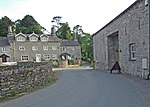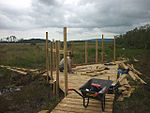Witherslack

Witherslack is a small village and former civil parish, now in the parish of Witherslack, Meathop and Ulpha, in the Westmorland and Furness district, in the south of Cumbria, England. It lies on the north eastern side of Morecambe Bay, England. The eastern side of the village borders Whitbarrow Scar with Yewbarrow, which is a small limestone hill, located in the centre of the village. In the 2001 census the former parish had a population of 482, increasing at the 2011 census to 499.Witherslack is quite scattered with four distinct areas. Townend, Mill Side, Beck Head and the school/church. Townend is traditionally considered the centre of the village and contains the local pub, The Derby Arms, and the Community Shop. Mill Side is the location of the old Mill and still contains the mill pond. Beck Head lies to the north of Mill Side and is where a small river emerges from the limestone escarpment adjacent to Whitbarrow. The area of the village with the Dean Barwick School and St. Paul's church lies to the west of Yewbarrow.
Excerpt from the Wikipedia article Witherslack (License: CC BY-SA 3.0, Authors, Images).Witherslack
Geographical coordinates (GPS) Address Nearby Places Show on map
Geographical coordinates (GPS)
| Latitude | Longitude |
|---|---|
| N 54.245 ° | E -2.859 ° |
Address
LA11 6RN , Witherslack, Meathop and Ulpha
England, United Kingdom
Open on Google Maps









